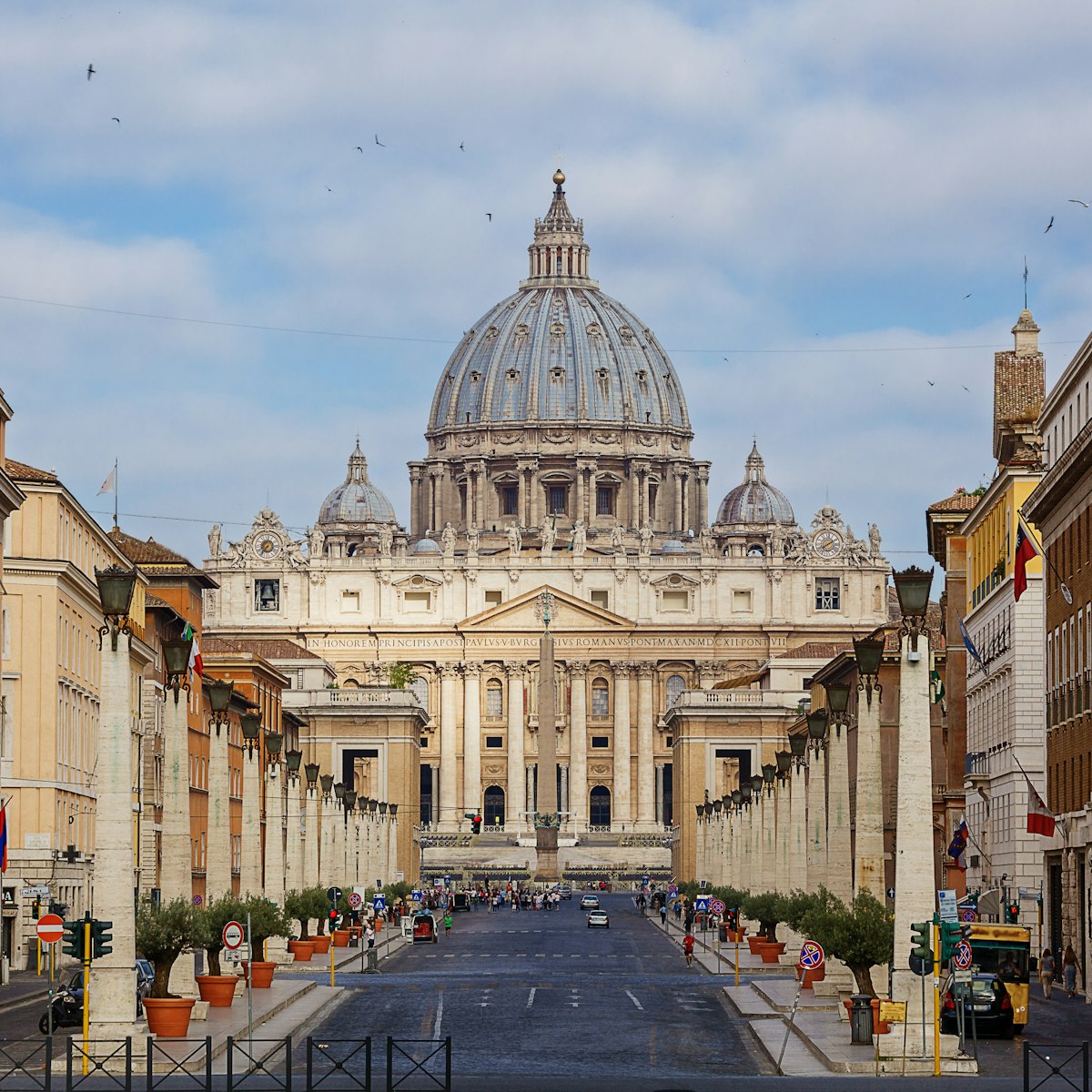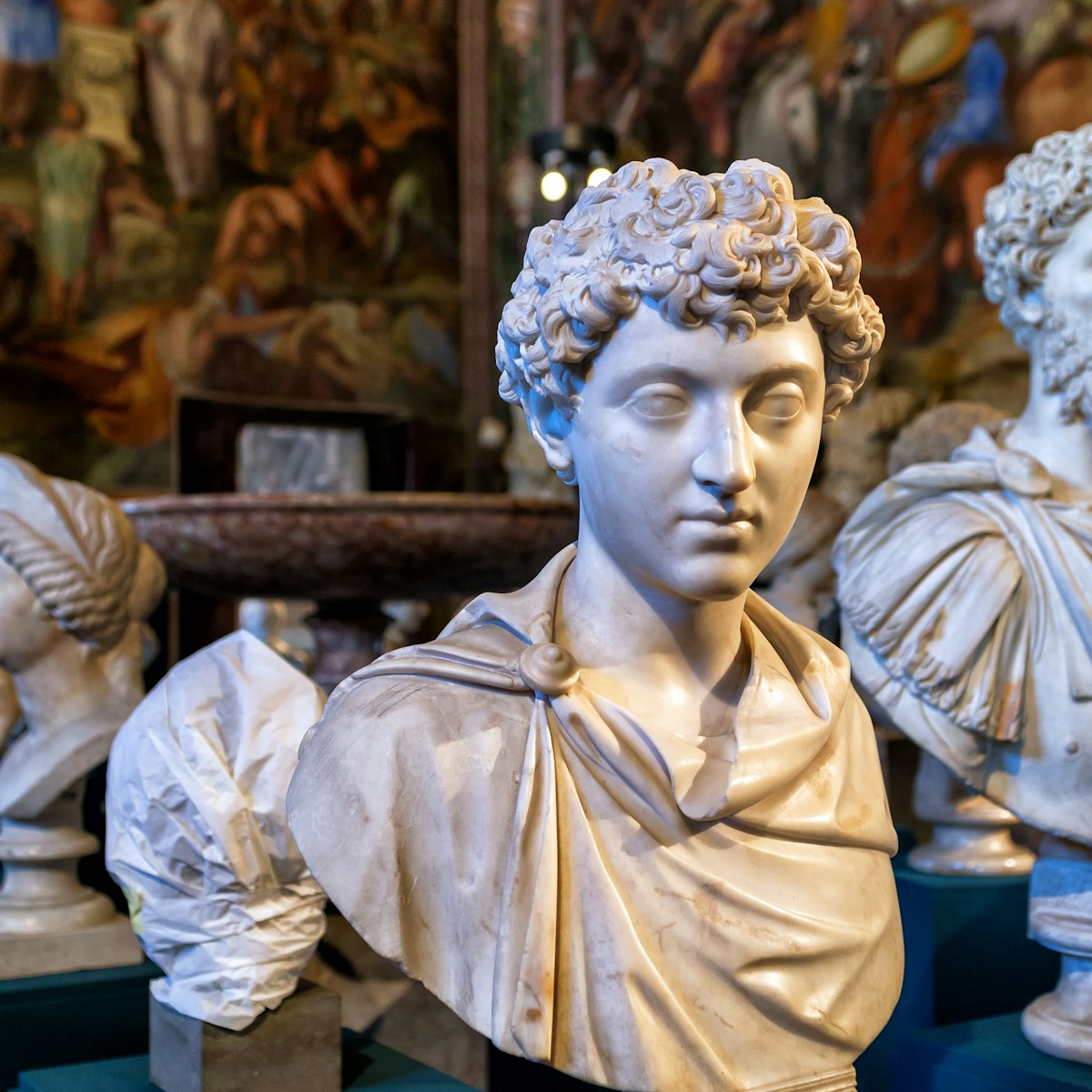An atmospheric area of towering pine trees, majestic ruins and memorable views, the Palatino (Palatine Hill) is the birthplace of Rome. This is where Romulus supposedly founded the city and where ancient Rome’s emperors lived in unabashed luxury.
Archaeological excavations have unearthed evidence of Iron Age settlements on the hill but much of what you see today dates to Roman times. In fact, much of the site is covered by the ruins of a 1st-century CE royal residence which served as the main imperial palace for 300 years.
The ruins can be complicated to decipher but look out for the stadio (stadium), the Domus Flavia and Domus Augustana (the public and private parts of the palace), and the Orti Farnesiani (a Renaissance garden with swoon-inducing views over the Roman Forum).
History of the Palatino
The first of Rome’s seven hills, the Palatino is central to the city’s creation story. Hard-nosed realists point to the establishment of a hut village on the hill in the early Iron Age (around the 9th century BCE) – for which there’s ample archaeological evidence. Romantics refer to the legend that Romulus killed his twin Remus and established Rome on the Palatino in 753 BCE.
Whichever version you prefer, the city flourished and by the 1st century BCE, the hill had become Rome’s most exclusive neighborhood. Its cooler, cleaner air and position above the Roman Forum led many wealthy patricians to set up home here. Emperors later followed suit. Augustus lived here all his life and successive emperors built increasingly opulent palaces – in fact, the word "palace" derives from the hill's Latin name, Palatium.
After the fall of the Roman Empire, the area was pretty much abandoned until rich Renaissance families reclaimed the land, building villas in the ruins and laying out gardens and vineyards.
Exploring the ruins
The hilltop can be accessed from two sides – from Via di San Gregorio to the east or through the Roman Forum to the north. Either way, it’s a short, steep climb to the summit area where you’ll find the principal sights.
Once up top, look out for a tall, white-ish building. This is the Museo Palatino, a small museum whose exhibits illustrate the development of the surrounding area. It also provides a useful point of reference for getting your bearings.
Northwestern area
To the north and west of the museum, you’ll find the remains of the Domus Flavia, the public part of the imperial palace. This was centered on a grand peristilio (peristyle or porticoed courtyard – the grassy area with the base of an octagonal fountain) off which the main halls led. To the north was the emperor's audience chamber (aula Regia); to the west, a basilica where the emperor judged legal disputes; and to the south, a large banqueting hall, the triclinium.
Signposted from near the Domus are the Casa di Livia (currently closed), the home of Augustus' wife Livia, and the Casa di Augusto, Augustus' private residence. This features some superb frescoes but can only be visited on a guided tour and with a Full Experience or SUPER ticket.
Near the Casa, but closed off to visitors, is the Villaggio di Capanne (Hut Village), the oldest part of the Palatino where a local shepherd supposedly brought up Romulus and Remus.
Continuing towards the Forum from here, you’ll come to the 16th-century Orti Farnesiani, one of Europe's earliest botanical gardens. This is a lovely shady area with a monumental balcony providing breathtaking views over the Roman Forum.
Eastern sector
The ruins that extend behind and to the east of the Museo Palatino are what’s left of the Domus Augustana, the emperor's private part of the palace. This was built on two levels, with rooms leading off a peristyle on each floor. You can't get down to the lower level, but from above you can see a square water feature and sweeping views over the Circo Massimo.
Also here are the Aula Isiaca and Loggia Mattei, two of several sites accessible with a SUPER ticket. The former is a frescoed room from an ancient Republican-era house; the latter is a Renaissance loggia decorated by Baldassarre Peruzzi.
Nearby is one of the few recognizable structures on the site – the stadio. This sunken area, which was part of the main imperial palace, was probably used by the emperors for private games and events.
Closed-off areas
At the time of research, several parts of the Palatino were closed to visits, including a scenic path that skirts the hill's southern flank.
Plan your visit
The Palatino and Roman Forum form part of a single unified site which, together with the Colosseum, comprises the Parco Archeologico del Colosseo.
Tickets come in three forms: a standard 24-hour ticket (€16) which covers the Palatino, Roman Forum and Colosseum but does not include the so-called SUPER sites (the Museo Palatino; Aula Isiaca and Loggia Mattei; Casa di Augusto; Criptoportico Neroniano). To enter these, you’ll need a Forum Super Pass (€16) or a Full Experience ticket (€22). These can be bought online (plus €2 booking fee) or at the Colosseum ticket office (with plastic only) on Piazza del Colosseo.
The Palatino opens from 9am to one hour before sunset and is easily walkable from Colosseo or Circo Massimo metro stations (both line B).
As a rough guide, allow about three hours for the Palatino and Forum.
The Palatino, Forum and Colosseum – in what order?
If you have to cover all three sites on the same day and you have an early time slot for the Colosseum, it makes sense to do the Palatino after the Colosseum and Forum. Conversely, if you’re going to the Colosseum in the afternoon, cover the Palatino first, then the Forum and Colosseum.
Places to eat nearby
There are no great eating options in the immediate vicinity so head over to the Circo Massimo. There you can grab a casual bite at 0,75, a popular bar-restaurant, or sit down to traditional Roman fare at the rustic Osteria Circo.









